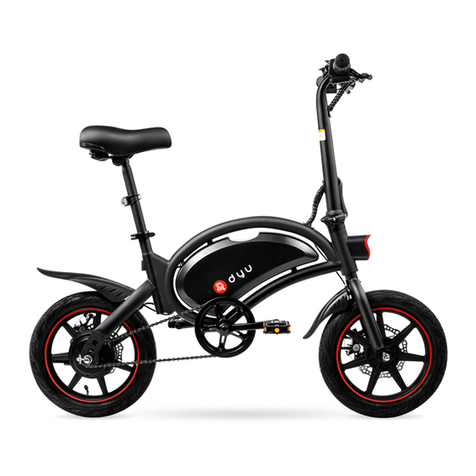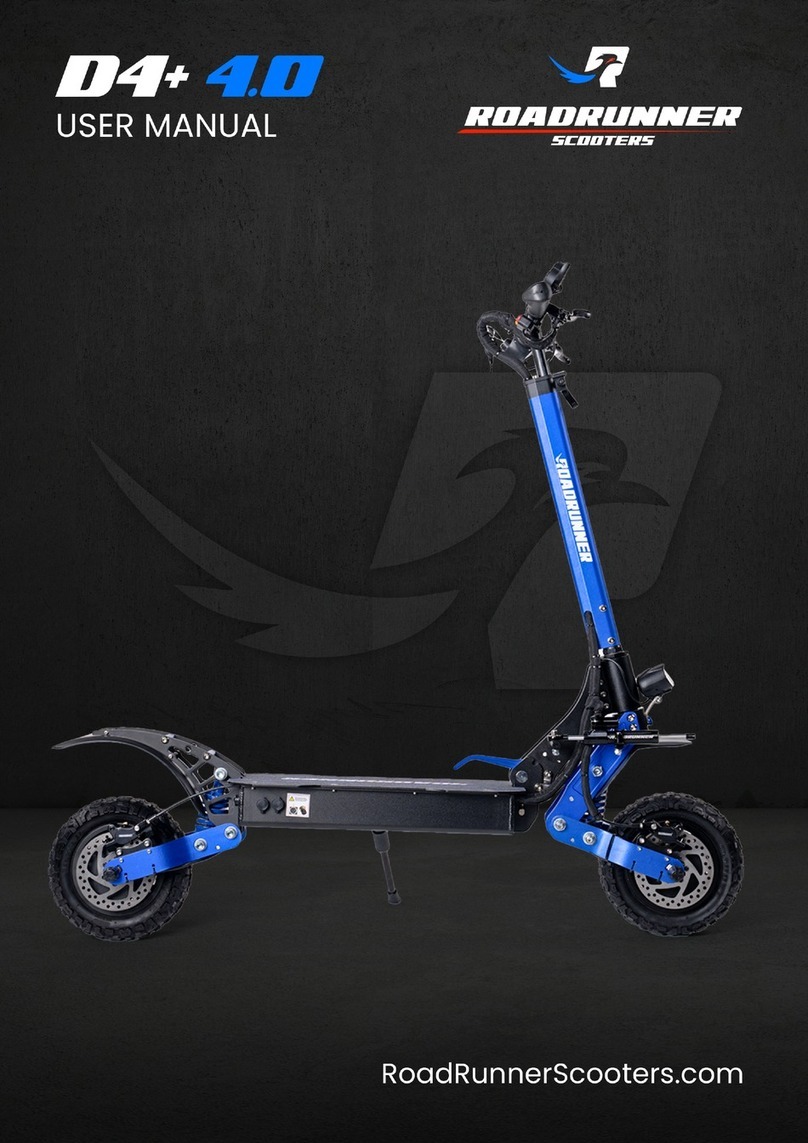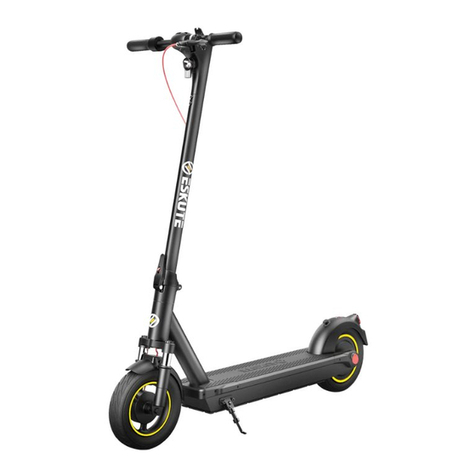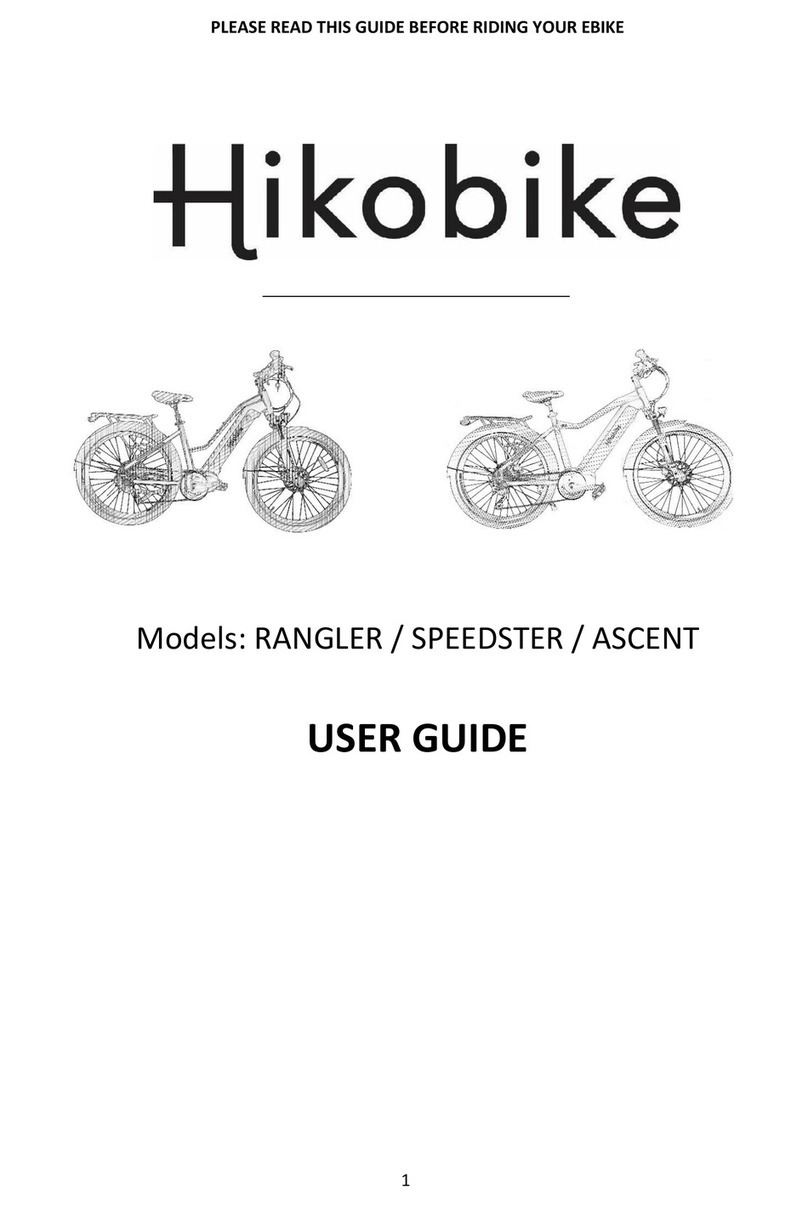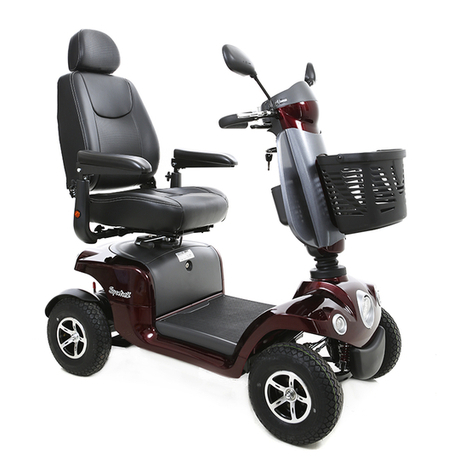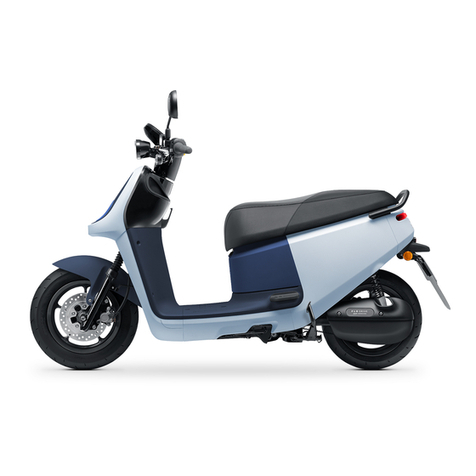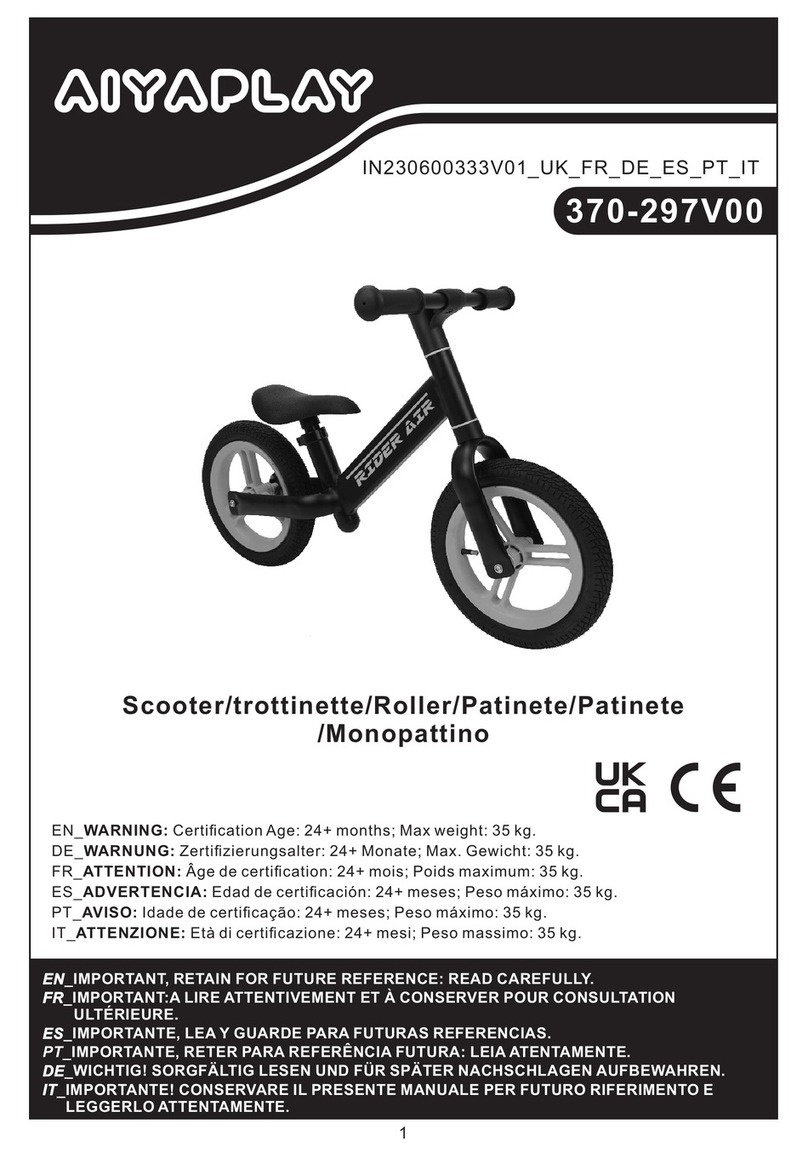Nipponia Volty User manual


Owner's Manual
Nipponia S.A.
EN

2
Thank you for purchasing the NIPPONIA VOLTY. This model is designed for safety, built for durability and
perfected for daily
street use.
The superior vehicle design and built-in technology will meet your expectations for an economical and eco-friendly lifestyle.
This Owner’s manual contains basic instructions on how to operate, inspect and maintain your scooter. Please read it carefully
and thoroughly. Correctly operating, maintaining and repairing your scooter will minimize any possible risks and result in its
best performance.
The authorized Nipponia service points will be glad to provide you with more detailed instructions.
INTRODUCTION EN

IMPORTANT MANUAL INFORMATION EN
3
Important information contained in this manual is marked using the following symbols:
Important information or instructions. Failure to follow these instructions may result in heavy damage to
your scooter, serious injury or even death.
Important information or instructions. Failure to follow these instructions may result in damage to your
scooter or minor injury.
CAUTION
•This manual is an integral part of the scooter and must always accompany it, even in the event of a resale.
•If you have any questions concerning the contents of this manual or need further information regarding the operation of your
scooter, do not hesitate to contact your local Nipponia dealer.
•This booklet is compiled with the latest available information. However, due to constant improvements, modifications or
alterations may be made without prior notification. Updated versions can be downloaded from the Nipponia website
www.nipponia.com
Note: Product and specifications are subject to change without notice.
! WARNING
CAUTION

IMPORTANT MANUAL INFORMATION EN
4
Dealer label (stamp) here

5
INTRODUCTION……………………..........
2
Pre-operation check list.............................
26
Vehicle identification number (VIN).........
46
IMPORTANT MANUAL
INFORMATION........................................
3
Activating the motor…….............................
27
WARRANTY INFORMATION.................
47
TABLE OF CONTENTS...........................
5
Acceleration………………….....................
27
MAINTENANCE SCHEDULE.................
48
SAFETY INFORMATION.........................
6
Braking...........................................................
28
SERVICE PLAN......................................
49
DESCRIPTION OF THE VEHICLE........
10
Parking.........................................................
29
WIRING DIAGRAM.................................
50
Side view..................................................
10
PERIODIC MAINTENANCE AND
MINOR REPAIR........................................
30
SPACE FOR NOTES..............................
52
Controls and instruments..........................
11
Tyres.........................................................
30
MAIN COMPONENTS.................................
11
Tyre wear condition...................................
31
Main switch / steering lock.........................
12
Rim and Tyre information..........................
32
Dashboard unit...........................................
13
Rims..........................................................
32
Handlebar switches –left...........................
14
Brakes…………….....................................
33
Handlebar switches –right........................
15
Brake pads…............................................
33
Front brake lever.......................................
16
Brake fluid.…............................................
34
Rear brake lever.......................................
16
Lubricating the levers................................
36
Seat..........................................................
17
Main stand.................................................
37
Power switch……………….......................
18
Front fork...................................................
37
Charger and charging socket…................
19
Steering.....................................................
39
Luggage box…….….................................
20
Wheels bearings.......................................
39
Front hook, helmet….................................
21
Lighting......................................................
40
Top case & rear carrier (optional).............
21
TROUBLESHOOTING..............................
41
Side stand....…….….................................
22
CLEAN AND STORAGE..........................
42
BATTERY INFORMATION …..................
23
Cleaning the vehicle..................................
42
Battery.......................................................
23
Storage......................................................
44
Battery storage………...............................
25
SPECIFICATIONS....................................
45
OPERATION AND DRIVING
INSTRUCTIONS........................................
26
CONSUMER INFORMATION...................
46
TABLE OF CONTENTS EN

SAFETYINFORMATION EN
6
Safe riding
1. Always perform the pre-operation inspection before driving.
2. The scooter should not be used by anyone who does not hold a valid driving license.
3. Many accidents involve motorcycles not seen by other drivers, so please pay attention to the following:
•Wear brightly-coloured clothes.
•Do not drive too close to other vehicles or in another driver’s blind spot.
•Avoid overtaking.
4. Always follow local traffic regulations.
•Driving above the speed limit is the reason for many accidents. Driving speed must not exceed the limit specified by traffic
regulations and allowed by road conditions.
•Always signal when turning or changing lanes in order to attract the attention of the other drivers.
5. Never drive under the influence of alcohol or other drugs; it dramatically increases the risk of accidents.
6. Exercise special attention when driving over crossroads or parking area exits.
7. When driving you must hold the handlebars with both hands and place your feet on the footboard. The passenger should hold the
handgrips or the driver and place his feet on the footrests.
8. This scooter is designed for on-road use only. It is not suitable for off-road use.
Protective clothing
1. For your safety, the driver and passenger should both wear helmets. Use of additional safety apparel (gloves, glasses, protective
wear) is recommended.
2. Do not wear loose clothing, as it may be caught by the handle levers, the kick starter or the wheels and could lead to an accident.

SAFETYINFORMATION EN
7
Vehicle modifications
Making any modifications to the scooter or replacing the original components can affect its performance and safety and/or render it
illegal for use. Observe applicable laws and all national and local regulations concerning vehicle equipment. Additionally, such
modifications will cancel the warranty.
Loading
Adding accessories or cargo to your scooter can adversely affect stability and handling if the weight distribution of the scooter is
changed. Use extra care when riding a scooter with extra load. Here are some general guidelines to follow when loading cargo or
adding accessories to your scooter:
1. All accessories must be fastened securely on the vehicle in order to minimize vibration that could cause instability.
2. Any extra load should be placed as close to the gravity centre as possible and must be equally distributed on both sides of the scooter
to avoid imbalance and instability.
3. The tyre pressure must be adapted to the weight of the load and road conditions.
4. Make sure that any extra load is securely attached to the vehicle to prevent it from falling and being lost.
5. Do not hang any load on the handlebars or the suspension.
6. The total weight of the driver, passenger, accessories and cargo must not exceed the maximum load limit of the scooter (150kg).
Maximum load: 150 kg
(Total weight of rider, passenger,
cargo and accessories)
Total weight of rider, passenger, cargo and accessories

SAFETYINFORMATION EN
8
Accessories
When installing accessories not approved by Nipponia, attention should be paid to the following points:
1. The installation of the accessories must not affect the suspension travel, the light position and the steering angle.
2. Avoid installing any accessories that could hinder your access to vehicle controls and movement of your hands and feet as it could
impair your reaction in an emergency event.
3. Do not install a bulb with higher power than that specified. It could burn the fuse or cause problems to the electrical system due to
low voltage.
4. Do not add a sidecar to the scooter.

SAFETYINFORMATION EN
9
Serial number

DESCRIPTION OF THE VEHICLE EN
10
Side view
1. Front wheel
2. Front disc brake
3. Front turn signal light
4. Headlight
5. Seat lock
6. Seat
7. Main Battery
8. Seat box
9. Taillight / brake light
10. Rear turn signal light
11. License plate light
12. Rear disc brake
13. Rear wheel
14. Main stand
15. Side stand
16. Optional battery

DESCRIPTION OF THE VEHICLE EN
11
Controls and instruments
16. Left handlebar switches
17. Rear brake lever
18. Dashboard unit
19. Right handlebar switches
20. Front brake lever
21. Throttle grip
22. Main switch

MAIN COMPONENTS EN
EN
12
MAIN SWITCH / STEERING LOCK
The main switch/steering lock controls the ignition and lighting systems and is also used to
lock the steering wheel. The switch can be turned to the following positions:
ON
All electrical circuits are supplied with power and the motor is active. The key cannot be
removed.
OFF
The motor and the electrical system are off. The key can be removed.
Steering lock
The steering is locked and cannot be turned, the motor and the electrical system are off and the key can be removed.
Lock the steering
1.Turn the handlebar all the way to the left.
2.Press the key down and while pressing, turn to the steering lock position.
3.Remove the key.
Unlock the steering
Press the key down and while pressing, turn to OFF position.
Never turn the key to OFF or LOCK position, while the vehicle is moving,
otherwise the electrical system will be switched off,
which may result in loss of control or an
accident. Make sure that the vehicle is stopped before turning the key.
! WARNING

MAIN COMPONENTS EN
EN
13
DASHBOARD UNIT
Left turn signal indicator lamp (1)
The left turn signal indicator lamp flashes whenever the
turn signal switch is pushed to the left side.
High beam indicator (2)
Indicates that the high beam switch is in ON position.
Right turn signal indicator lamp (3)
The right turn signal indicator lamp flashes whenever the turn
signal switch is pushed to the right side.
Speedometer (6) and odometer (4)
The dashboard unit is equipped with a speedometer and an
odometer. The speedometer shows the riding speed.
The odometer shows the total distance traveled and the trip distance is reset every time the main switch is turned off.
Speed limit indicator (5)
Indicates the speed limit mode, for 25km/h (mode 1) or 45km/h (mode 2), respectively.
Battery level gauge (7)
The battery level gauge indicates the power remaining before re-charging is required. The same is also indicated with a numerical
value expressed in percentage form.

MAIN COMPONENTS EN
EN
14
HANDLEBAR SWITCHES - LEFT
1. High/Low beam switch
2. Turn signal switch
3. Horn button
High/Low beam switch (1)
Set the switch to position for the high beam.
Set the switch to position to for the low beam.
Turn signal switch (2)
Push this switch to position to signal a left-hand turn or to position to
signal a right-hand turn.
To turn-off the signal lights press the switch in the centre of the switch.
Horn button (3)
Press the button to position to sound the horn.

MAIN COMPONENTS EN
EN
15
HANDLEBAR SWITCHES - RIGHT
1. Speed limit switch (ECO/FAST)
2. Light switch
3. Cruise control button
Speed limit switch (ECO/ FAST) (1)
If
you set the switch to “ECO” the maximum speed of the vehicle is limited to 38
km/h.
If you set the switch to “FAST” the maximum speed of the vehicle will be 45 km/h.
The speed limit function is only applied on 45 km/h version.
Light switch (2)
It has two positions: and
Turn the light switch to this position to turn on the daytime running light, dashboard light and taillight.
Turn the light switch to this position to turn on the headlight.
Cruise control button (3)
This model is equipped with a cruise control system, designed to maintain a constant cruising speed. Press the cruise control
button to activate cruise control functionality. Whenever the front or rear brake is applied, the cruise control function will be
deactivated.

MAIN COMPONENTS EN
EN
16
•Do not activate the cruise control button in heavy traffic or in bad weather conditions.
•Do not activate the cruise control button when travelling uphill or downhill.
FRONT BRAKE LEVER
The front brake lever is located on the right handlebar grip.
To apply the front
brake, pull this lever towards the grip.
REAR BRAKE LEVER
The rear brake lever is located on the left handlebar grip.
To apply the rear brake, pull this lever towards the grip.
! WARNING

MAIN COMPONENTS EN
EN
17
SEAT
To open the seat, set the vehicle on the side stand or the centre stand.
Then turn the key a quarter turn to the left.
Do not press the key down when turning the key.
To close the seat, lower the seat and push the rear part of the seat until you hear a clicking sound. This
indicates that the seat is locked.
When you close the seat using force, parts may be damaged.
Always make sure that the seat is securely locked before driving or when you park the vehicle.
CAUTION
CAUTION

MAIN COMPONENTS EN
EN
18
POWER (RECIPROCAL) SWITCH
The reciprocal switch is installed under the seat area of your vehicle. This switch can shut down the main power supply.
(1) (2) (3)
If you want to activate the main battery (vertical arrangement), make sure that the switch 1 is in ON position, then the switch 2 will be
automatically turned to OFF position, see photo (1)
If you want to activate the optional battery (horizontal arrangement), turn switch 2 to ON position. Switch 1 will be automatically turn
to OFF position, see photo (2).
If you want to turn off the power switch of the vehicle, set both switches to OFF position, see photo (3).
If the electrical system is overloaded, the power switch will act as a circuit breaker to prevent any damage to your vehicle.
CAUTION
21
21
21

MAIN COMPONENTS EN
EN
19
The two switches can not be both turned to ON position.
CHARGER AND CHARGING SOCKET
With the vehicle you will also receive a charger to charge the battery of the vehicle.
If the battery level gauge on the dashboard unit drops below two dashes, recharge the vehicle as soon
as possible.
The charging socket (2) is located at the front of the seat and is directly connected to the battery
(main or optional, depending on the position of the power switch, see pg. 18).
Other manuals for Volty
1
Table of contents
Other Nipponia Scooter manuals
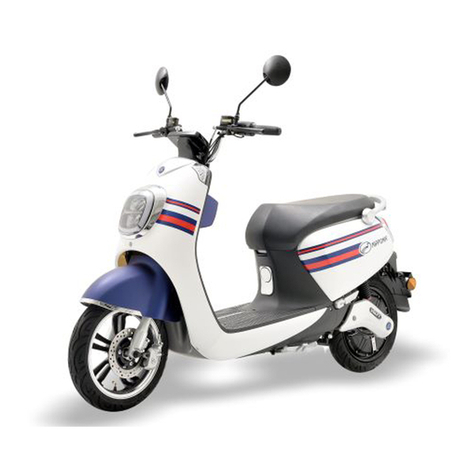
Nipponia
Nipponia Volty Instruction manual
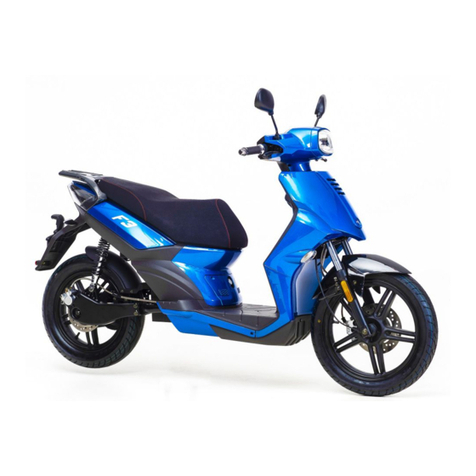
Nipponia
Nipponia F3 User manual
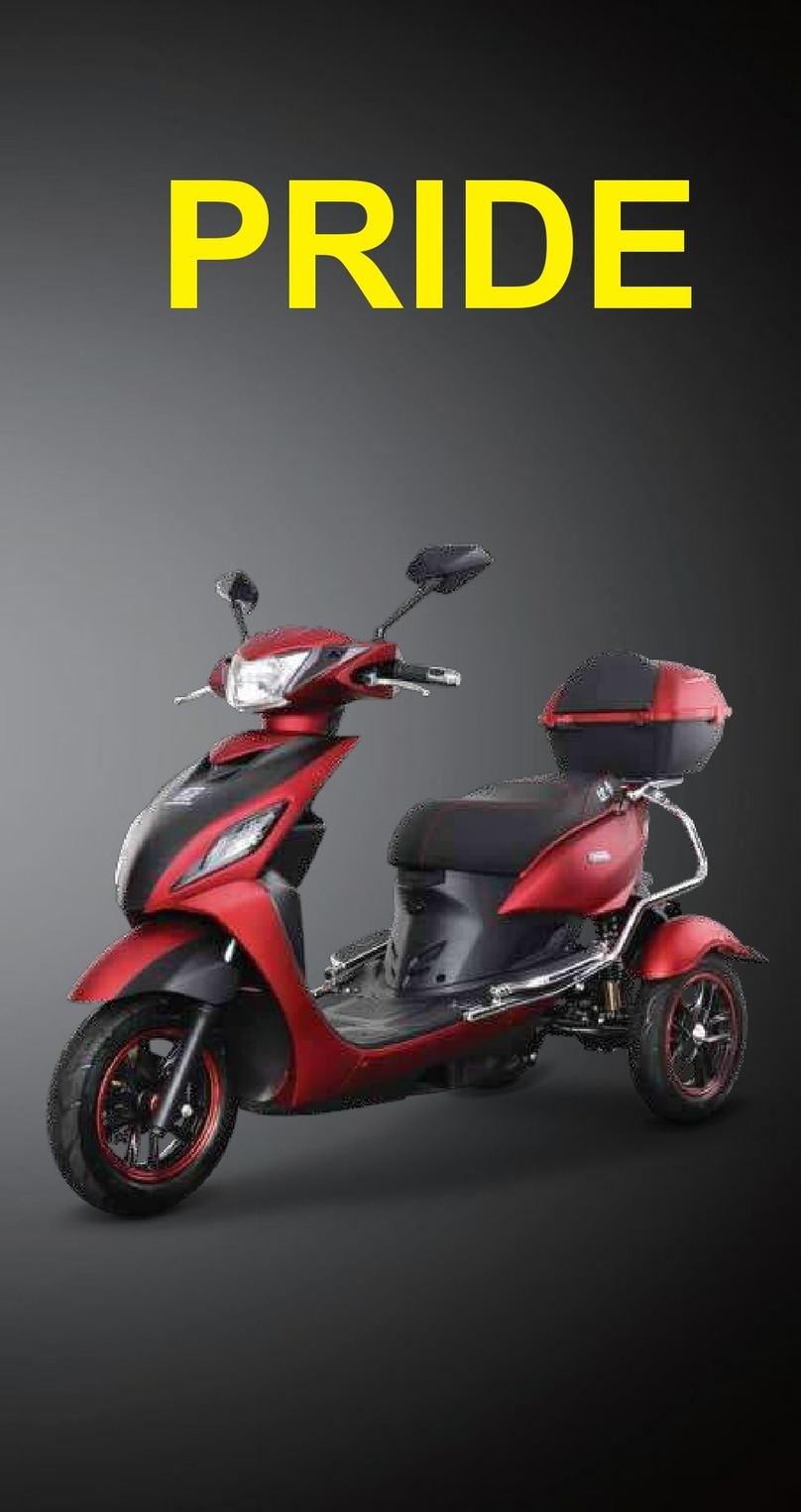
Nipponia
Nipponia PRIDE User manual
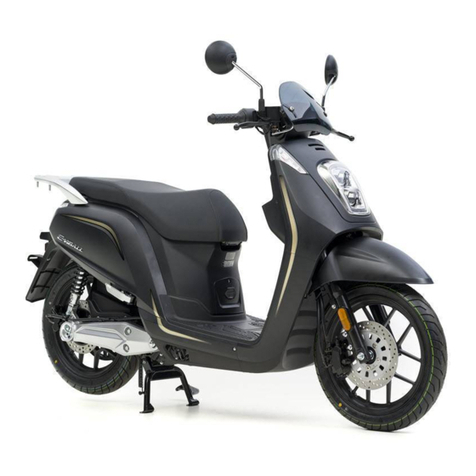
Nipponia
Nipponia E-Viball 1S Instruction manual
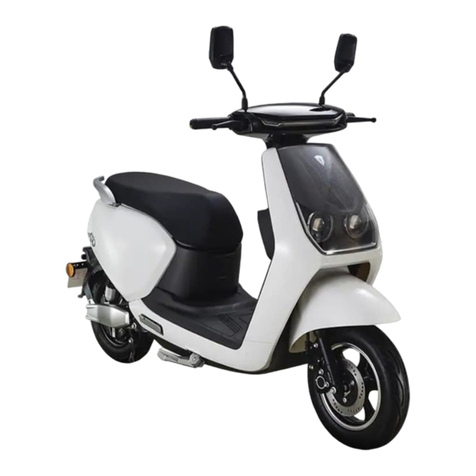
Nipponia
Nipponia Cit-e User manual
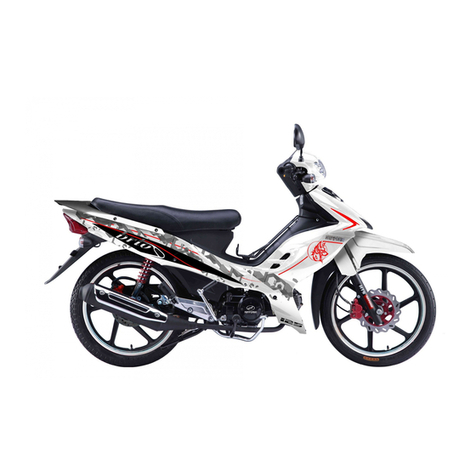
Nipponia
Nipponia BRIO 125-3 User manual
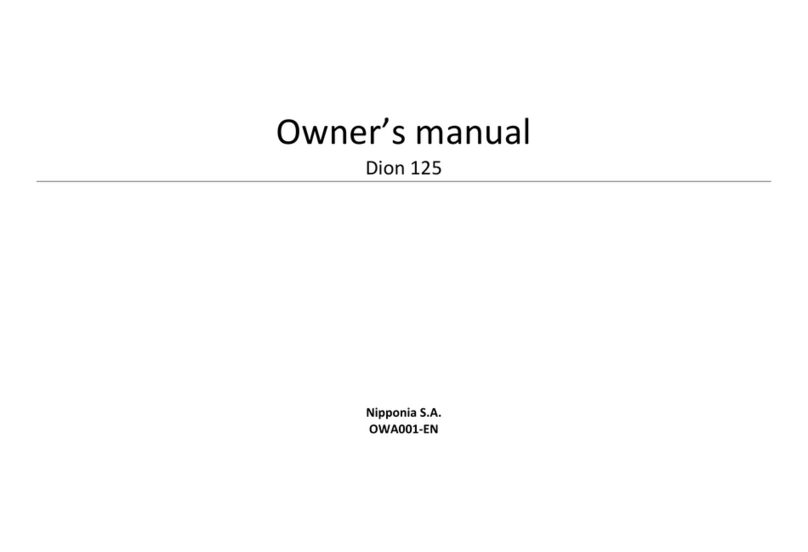
Nipponia
Nipponia Dion 125 User manual
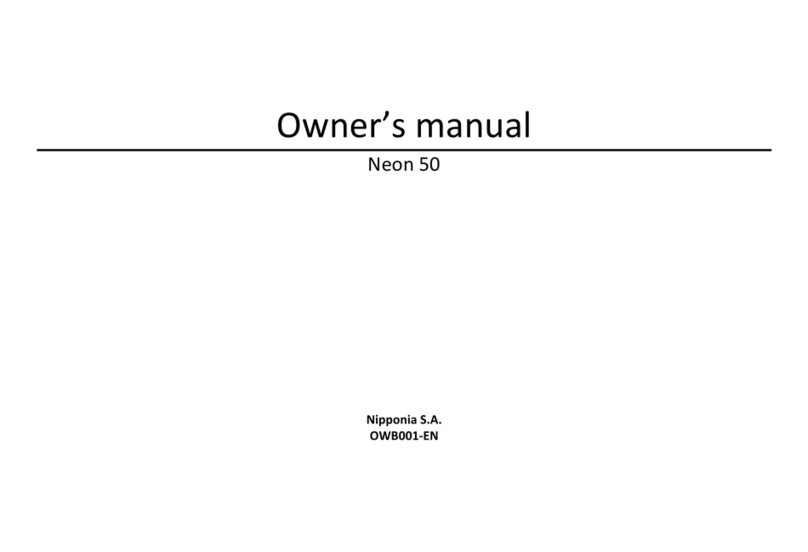
Nipponia
Nipponia Neon User manual
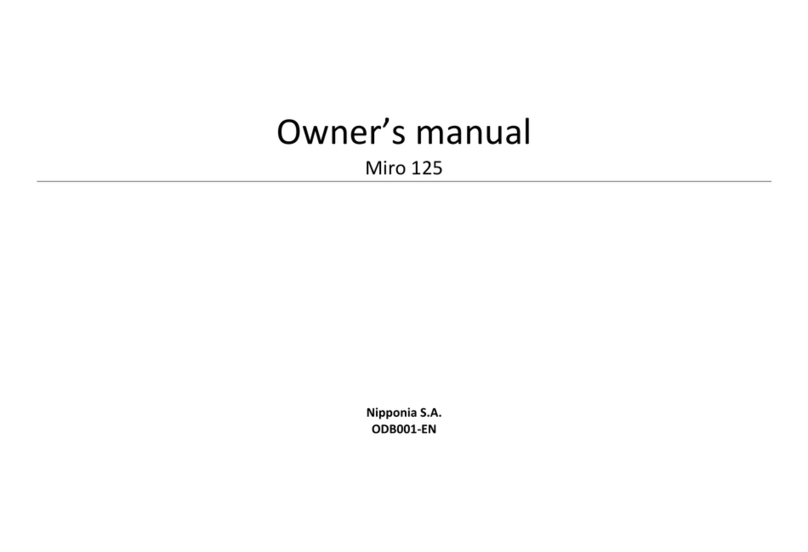
Nipponia
Nipponia Miro 125 User manual
Popular Scooter manuals by other brands
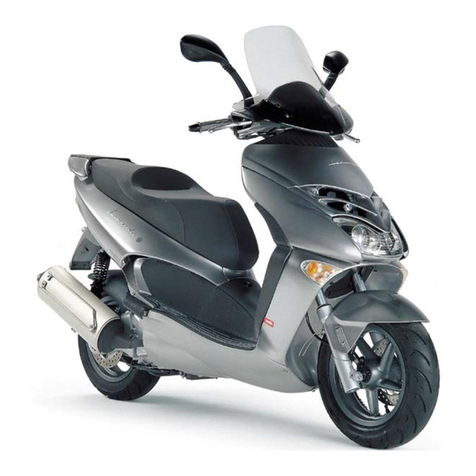
APRILIA
APRILIA LEONARDO 125 manual

Drive Medical
Drive Medical Scout Owner's handbook
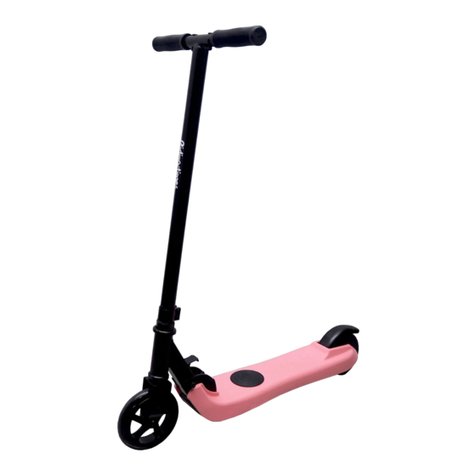
Riding'Times
Riding'Times Q2 user manual

Golden Technologies
Golden Technologies buzzaround GB 101 owner's manual
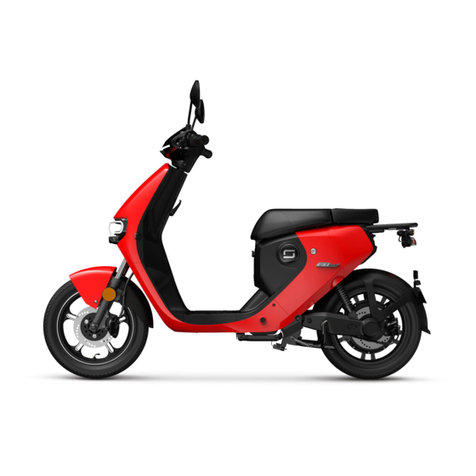
SOCO
SOCO CU mini user manual

Mi
Mi Electric Scooter Pro 2 Mercedes-AMG Petronas F1 Team... Important information
